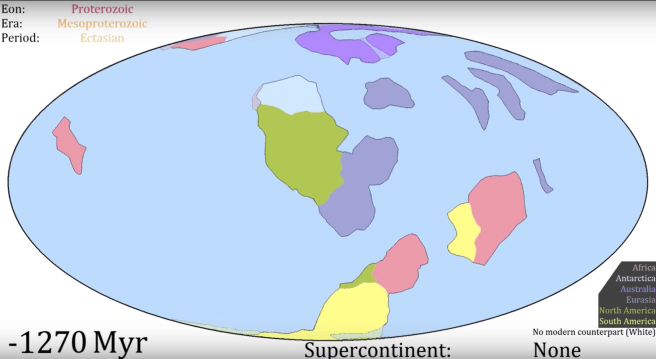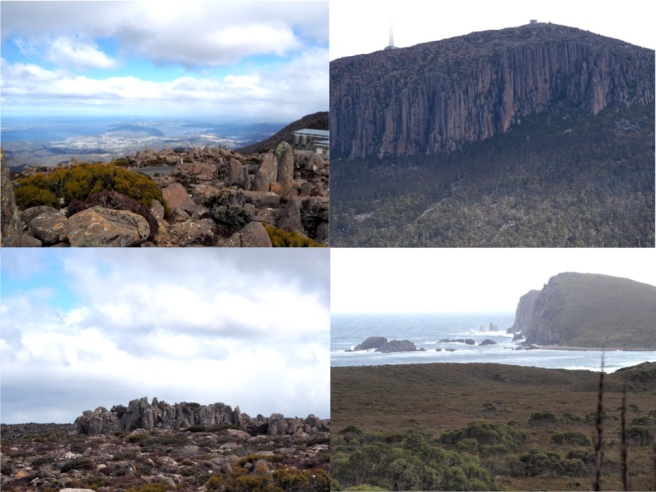I visited Tasmania in the September of 2017 along with my family. This was our first vacation in months, so we were very excited. I didn’t do much research on Tasmanian geology and ecology until I stumbled upon some amazing sights. The fossils of some early animals in the Bruny island, the organ pipes of Mount Wellington and the biodiversity in the botanical garden kindled the child in me to learn more about them. I want to summarise my learnings and amazement in this blog.
The earliest record of geological history in the Tasmanian rocks dates back to 1.27 billion years. As amazing as that stat is, I want to put it to perspective. This rock was formed when the earth looked like below. This predates any of the known supercontinents that we now understand existed.

Courtesy: Youtube video on Continental Drift
These rocks actually predate plants as we know them and even sexual reproduction. Just think of the timeline of life.
 Courtesy: Wikipedia
Courtesy: Wikipedia
Fossils @ Bruny Islands
As I was getting amazed by these facts, we made a trip to the Bruny Islands. It is a small island almost half the size of Singapore with a population of 600 people. I witnessed something truly amazing there. I saw some rocks with fossilised animals from ancient times. These pictures were taken from the rocks and the exhibits at the Inala Jurassic Garden. I have a very little clue of the animals these fossils belong. The one in the bottom right does look like a fossil of a brachiopod but I am by no means sure. However, these fossils did give me an impression of a journey to the lost worlds of the past.

The story of the rocks
Ancient rocks tell stories which amaze me more than any fiction or any myths can ever achieve. It is hard to not get astonished by rock formations in Tasmania. From the organ pipes in the Mount Wellington and the Bruny islands to the amazing cliffs which drop to one of the three oceans (the Southern Ocean to the south, the Indian Ocean to the west and the Pacific ocean to the east), Tasmania is a geological wonderland. As I mentioned, I had no clue of the reasons behind the wonders until I looked at them and got curious. Now, I want to share the pleasure I had when I learnt about these marvels. I have also provided the reference below.

In order to understand the origin of these organ pipes, we have to understand what is beneath these. The foothills of Mount Wellington has layers of sedimentary rocks. The bottom layer is mudstone formed during the Permian period (230-280 million years ago). The mudstones are creamy white to grey in colour. On top of the mudstone, one can see a layer of quartz-rich sandstone formed during the Triassic period(180-230 million years ago). These sandstones were formed from the various rivers and rivulets of the times.
What followed next was one of the five mass extinction events in the history of the earth, the End-Triassic extinction. This happened about 200 million years ago. This was followed by a volcanic activity. The molten magma flowed, solidified and with time cooled to form shrinkage cracks. This resulted of the large vertical columns with polygonal cross-sections. This can be seen in the thick sheet of dolerite in the region.
This event also coincided with the breaking of the supercontinent Pangea. The continental drift as a result of the plate tectonic movements resulted in the creation of the two supercontinents, Laurasia and Gondwana from the single supercontinent of Pangea. The tilted block faulting caused by these tectonic plates stretching was responsible for the creation of the landscape. The rocks have since been eroded to expose the formation we call organ pipes. The exposure to the erosion has resulted in the dolerite sheets getting the colour of rust. Unexposed to these natural forces, dolerite has a bluish grey colour.

Courtesy: www.britannica.com

Courtesy: Wikipedia
The ecological diversity
The formation of Gondwana (as seen above) after the great mass extinction of the Triassic period, ignited a new ecology of flora and fauna in Tasmania. Tasmania is a home to some of the most unique vegetation from the largest marsupial carnivore in the Tasmanian Tiger to the tall eucalypt trees. I saw some amazing flora in the Bruny islands which evolved during the Gondwana period (picture below). These plant species have since survived major continental drifts and another mass extinction 64 million years ago.

The botanical garden in Hobart is another magnificent site of nature. The variation of the flowers in the ecology not bruised by human intervention for long was an awesome sight.

Charles Darwin visited Hobart in the February of 1836 during his famous voyage in the Beagle. He wrote about what he saw in Hobart in the journal. Here is an excerpt from the same.
“.. In many parts the Eucalypti grew to a great size, and composed a noble forest. In some of the dampest ravines, tree-ferns flourished in an extraordinary manner; I saw one which must have been at least twenty feet high to the base of the fronds, and was in girth exactly six feet. The fronds forming the most elegant parasols, produced a gloomy shade, like that of the first hour of the night. The summit of the mountain is broad and flat, and is composed of huge angular masses of naked greenstone. Its elevation is 3,100 feet [940 m] above the level of the sea. The day was splendidly clear, and we enjoyed a most extensive view; to the north, the country appeared a mass of wooded mountains, of about the same height with that on which we were standing, and with an equally tame outline: to the south the broken land and water, forming many intricate bays, was mapped with clearness before us. …”
I don’t think I can summarise my feeling more eloquently than the great man himself. I want to use the lines from the famous poem by William Wordsworth to showcase my feelings.
“…
For oft, when on my couch I lie
In vacant or in pensive mood,
They flash upon that inward eye
Which is the bliss of solitude; ..”
References
- https://www.wellingtonpark.org.au/assets/wellingtonpark_geology.pdf
- http://www.parks.tas.gov.au/?base=1484
- https://www.britannica.com/science/plate-tectonics/Development-of-tectonic-theory
- https://www.britannica.com/science/extinction-biology#ref281253
- https://en.wikipedia.org/wiki/Mount_Wellington_(Tasmania)

Super description of Tasmania visit.
LikeLike